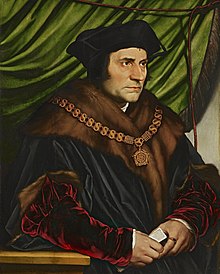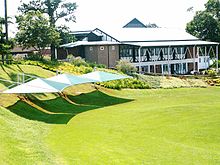Thomas More College (South Africa)
This article needs additional citations for verification. (March 2023) |
29°47′17″S 30°51′10″E / 29.788147°S 30.852817°E
| Thomas More College | |
|---|---|
 | |
| Location | |
 | |
| , South Africa | |
| Information | |
| Type | Independent |
| Motto | Vincit Omnia Veritas |
| Established | 1962 |
| Locale | Kloof, KZN |
| High School Headmaster | Meshen Govender |
| Exam board | IEB |
| Grades | 000–12 |
| Number of students | 1163 |
| Colour(s) | Maroon, Black & White |
| Mascot | Moorcock |
| Tuition | R34 740 - R109 600 |
| Website | www |
Thomas More College is an independent, Catholic co-educational day school located in Kloof, near Durban in KwaZulu-Natal, South Africa.[1]
History
[edit]
Thomas More College opened on 1 February 1962 with 55 pupils, all boys.[2] Co-education was not to come for another 14 years. The founder and headmaster was Robin Savory, who wanted to start a Catholic school run by Catholic laity. In this he had the support of Archbishop Denis Hurley. From the start the school had a strong religious element [3] The school was named after Saint Thomas More at the request of Chris Hurley, co-founder, second headmaster and brother of Archbishop Denis Hurley.

The choice of Kloof as the site for the Thomas More School (as it was originally called) was due to the availability of the Great House, and the presence of a small core of likely pupils. However, at the time Kloof was a village with a scattering of shops and what was then a functioning railway station. What today are residential areas were then largely open grasslands, and Kloof High School was in fact Kloof Secondary, as in 1962 it only went as far as Standard 7 (Grade 9 in modern parlance). Between 1962 and 1992 (by which time the school's name had changed to the present Thomas More College) the school was served by three headmasters: Robin Savory, Chris Hurley and Bill Pickering.
Attendance numbers never rose above 197, comprising around 100-110 boarders, with the balance being 'day-boys'. This was despite the school going co-educational in 1976. By 1990 the school was facing closure. A campaign was launched to revive and expand it.
As part of this, a primary school was set up in the Farmhouse. In 1992 Peter Habberton was appointed as principal, and in 1993 the Junior Primary School opened. Much expansion in terms of buildings and other facilities took place. The boarding facility closed at the end of 2002 due to a significant drop in demand, and the rooms which became available as a result were converted to offices and specialist classrooms.
In 2002 Shane Cuthbertson followed Peter Habberton as principal. In 2009, due to re-structuring in the high school, Cuthbertson retained his position as principal of the whole school, and Allan Chandler, Senior Master at the time, was appointed as headmaster of the high school. A new hockey field, an all-purpose field and netball courts were created. At the end of 2006 a 25 m x 35 m swimming pool was completed. The Ken Mackenzie Centre appeared on the other side of the Savory Field. Pupil numbers have risen to 1 224, from Grade 0000 to Grade 12, making Thomas More College the largest independent school in KwaZulu-Natal. In 2012 Thomas More College celebrated a jubilee year for its 50th birthday.[4]
Today
[edit]The school is situated on a conservancy estate of 20 hectares and has 1 163 pupils. All pupils are put into houses (Hurley, Savory, or Dalberg) that compete against each other in events such as the interhouse galas and sports day as well as cultural events.

The Long Walk
[edit]The Long Walk (originally called "the fifty mile walk") is a tradition of Thomas More College, started in 1963.[5] The inspiration for the walk came from John F. Kennedy in 1962, when he challenged Americans to walk a 50-mile (80 km) event annually. In March every year, approximately 1 300 students, parents, past pupils, teachers and other visitors set off in the hope of completing the 80 km.
The earliest walks were from Pietermaritzburg to Greytown, away from Kloof. In the early 1960s there were no more than 30 participants on the Long Walk. Later walks still started in Pietermaritzburg, but students would then walk 80 km toward the coast, finishing at the school. It was easier than the walk to Greytown because there were fewer steep hills to walk up. In the 1970s, the walk started from, and finished in, the school grounds, with the bell adjacent to The Great House being rung when finishers arrived. In 1974, due to an error, the distance walked was 86 kilometers and only 21 people out of 350 starters finished the walk.
The current route starts from the school grounds in Kloof, and winds its way through the suburbs of Kloof and Hillcrest, before finishing back at the school Kloof.
From 2004, the finish was moved to Summerveld. In 2016 the route finish returned to TMC due to various safety concerns in the Summerveld area.
The Long Walk and attracts participants from all over KwaZulu-Natal as well as the rest of South Africa.[citation needed] In 2020 and 2021 the school cancelled the Long Walk due to COVID-19 restrictions on mass gatherings.[6]
Sports
[edit]
Thomas More is known for its competitiveness in terms of sports.[citation needed] The 1st cricket, hockey and waterpolo sides are regarded as some of the best in the area, while some players of individual sports have gained provincial colours.[citation needed]
The 1st Team Waterpolo sides (Boys' 1st and Girls' 1st) toured to Serbia in 2010, whilst the 1st Team Cricket and Rugby sides regularly go on tours. The 1st hockey teams also compete annually in at various tournaments across the country and have travelled internationally for various training camps.
Academics
[edit]TMC pupils write the Independent Examinations Board (IEB) exams.


Compulsory subjects include:
- English
- Afrikaans or isiZulu (as a first additional language)
- Life Orientation
- Mathematics Core or Mathematics Literacy
The students are also required to take at least three other subjects of their choice:
- Accounting
- AP Mathematics (Additional Subject)
- AP English (Additional Subject)
- AP Science (Additional Subject)
- Business Studies
- Design
- Dramatic Arts
- Engineering Graphics & Design (EGD)
- Geography
- History
- Information Technology (IT)
- Life Sciences (Biology)
- Marine Science (Additional Subject)
- Physical Science
- Visual Arts
School of Music
[edit]Thomas More College has its own school of music.

The School of Music at Thomas More College offers tuition for beginners to advanced pupils, and is open to all pupils in the Upper Highway community as well as adults. Exams are offered through Trinity College as well as Royal Schools in all practical and theoretical aspects of music. The following instruments are offered (private tuition):[citation needed]
- Piano
- Drums
- Guitar
- Flute
- Violin
- Voice training
Past Pupils’ Association
[edit]
The origins of the Past Pupils' Association can be traced back to 1973. Since co-education was not to come until 1975, it was the Thomas More Old Boys' Association that was formed with the dual aim of fostering relations between the Old Boys and the School, and amongst the Old Boys themselves.
In the 1980s and early 1990s, the association was struggling, but things changed circa 1998, when the Robin Savory Pavilion was built. This facility came under the control of the Thomas More Past Pupils' Association and was administered by that body in close co-operation with the school.
The Men's hockey teams continue to operate and a Ladies' team has been added. The Moorcock Chronicle, sent to everyone on the database, serves both as a mouthpiece for the Past Pupils and as a link with the school. The association co-hosts the annual Past Pupils' Association Day.
References
[edit]- ^ "Thomas More College • An Inspired Education". Thomas More College. Retrieved 3 October 2024.
- ^ "Thomas More College". Round Square. Retrieved 3 October 2024.
- ^ "Our History • Modern Education • Thomas More College". Thomas More College. Retrieved 3 October 2024.
- ^ [1]. Thomas More College : A Brief History. Retrieved 4 May 2016. [dead link]
- ^ Content, Print (7 March 2019). "Take Thomas More College's walk in your stride". Highway Mail. Retrieved 3 October 2024.
- ^ [2]. Thomas More College : Long Walk Information. Retrieved 4 May 2016.
